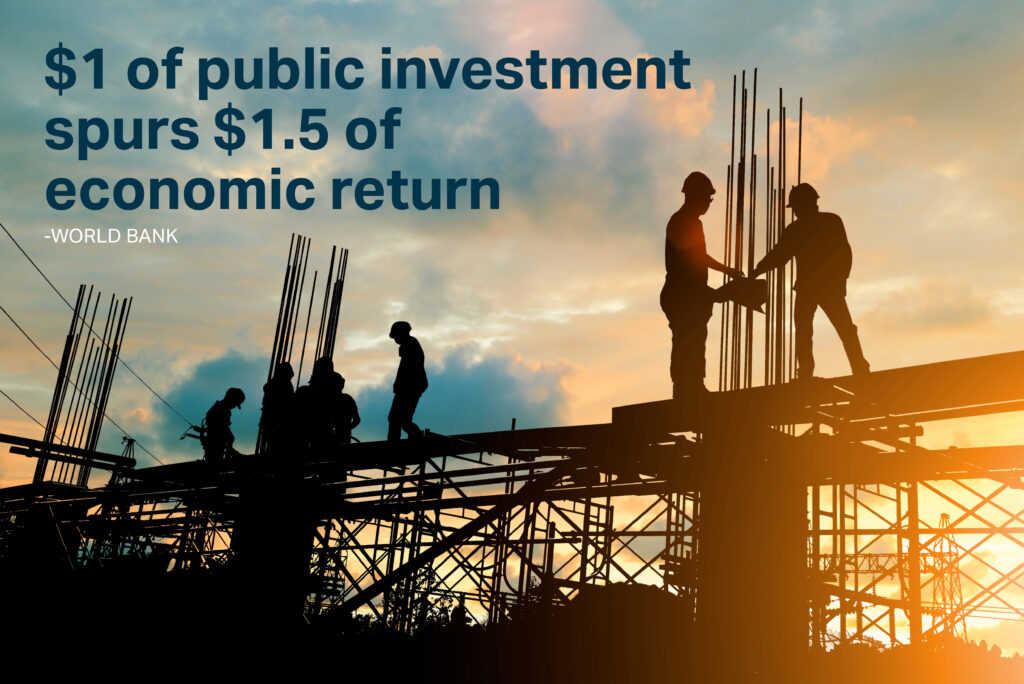Housing is Infrastructure
October 16, 2023
Recognizing housing as an essential piece of infrastructure not only increases equitable opportunities for vulnerable communities: it contributes to our resilience and progress as a country.

Housing and infrastructure are two seemingly distinct domains, yet understanding their interconnectedness is crucial to shape the progress of a nation. While infrastructure programs often conjure ideas of highways, bridges, and public utilities, housing is a cornerstone of this broader framework—not just a basic human need—and must be recognized as such.
Affordable and attainable housing contributes to the overall development and prosperity of a nation. According to recent studies, the U.S. has a shortage of 7.3 million affordable and available rental homes for individuals with extremely low incomes, and no state has an adequate supply of affordable units to meet these growing needs. Coupled with the 19 million American renters who spent 30% or more of their income on housing costs, it’s apparent that the U.S. is experiencing social instability and economic disparity.
The Infrastructure Improvements and Jobs Act (IIJA) signed into law in 2021 outlines a plan to increase the country’s competitiveness and invest in communities that have too often been left behind. Yet no part of this plan addresses the severity of chronic housing issues. If people are not housed, then the government and taxpayers cannot actualize the most fundamental benefits of any infrastructure investment.

Benefits of Investing in Housing as Infrastructure
Investing in housing as a component of infrastructure programs is a well-rounded approach to fostering an equitable and prosperous society and maximizes the return on costly infrastructure spending. This strategy can result in a myriad of positive environmental, social, and economic benefits, each playing a pivotal role in developing resilient and thriving communities at the local, state, and national levels.
Environmental Impacts
Low-income households, often residing in environmentally vulnerable areas, face greater challenges in relocating or rebuilding after disasters. By emphasizing low-income housing development projects that incorporate energy-efficient and sustainable features, we can enhance resilience to extreme weather and climate change impacts while also curbing greenhouse gas emissions—key ideas outlined in the IIJA.
Furthermore, these housing initiatives promote smart urban planning, reducing urban sprawl and thus preserving natural landscapes and biodiversity for a more sustainable future.
Social Impacts
Investing in housing infrastructure is a critical tool in the fight against homelessness, offering affordable housing options and support services that can substantially improve the lives of vulnerable populations. These investments also relieve the strain on social services, as stable housing promotes independence and reduces reliance on public assistance and health programs, thus leading to increased community well-being and public health.
Housing investments are also aligned with the goals of the U.S. Transportation and Infrastructure Committee, which holds jurisdiction over U.S. infrastructure and aims to strengthen community bonds, foster economic growth, enhance mobility, and promote equity by improving access to essential services. Yet without official acknowledgement from government entities that housing is infrastructure, this shared goal will perpetually be divided in resources and minimal in effectiveness.
Economic Impacts
From an economic standpoint, housing infrastructure is an engine for growth and productivity, which the IIJA aims to achieve. Housing infrastructure supports the bill’s efforts to create jobs during the construction and maintenance phases of housing projects and further boosts local economies by leveraging public and private resources to generate income and tax revenue. Moreover, the reduction in homelessness leads to cost savings in healthcare, emergency services, and welfare programs that ultimately reduce the tax burden on individuals and businesses.
Moving Forward
The state of our current housing landscape reflects the state of our society: A fractured housing system undermines our ability to function as a cohesive and prosperous nation and fully reap the benefits of expensive infrastructure programs. Without sufficient housing infrastructure, we jeopardize the stability and functionality of our communities, impeding our collective progress and prosperity.
To truly advance as a society and address the prevalent issues of homelessness and housing instability, we must recognize housing as an essential component of our nation's infrastructure and ensure every individual has a secure place to call home. Only then can our nation operate as a prosperous and resilient collective.
To learn more about the impacts and benefits of housing in federal and state infrastructure programs, download our Housing as Infrastructure White Paper.


